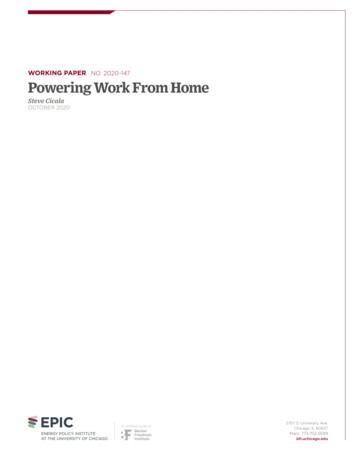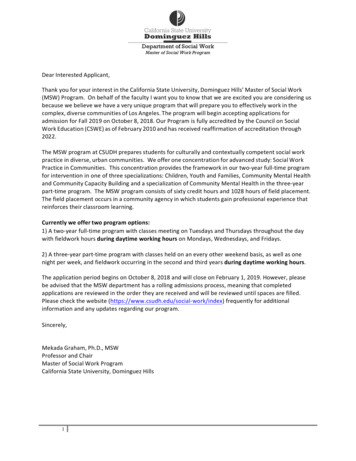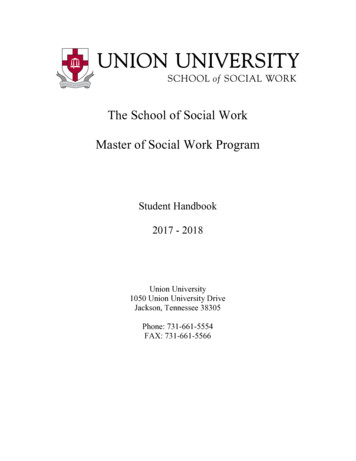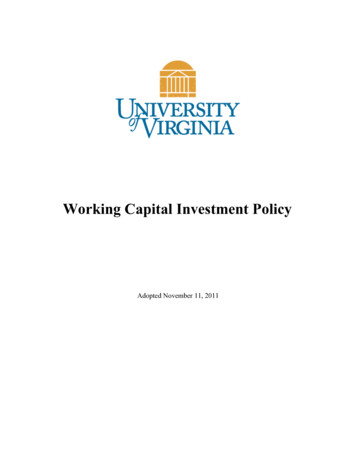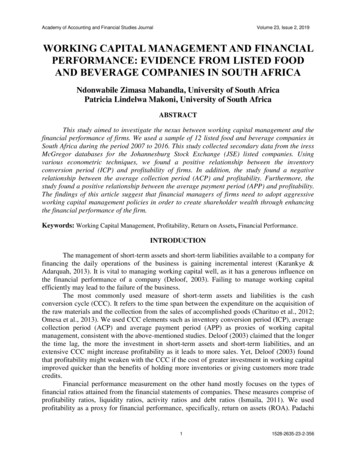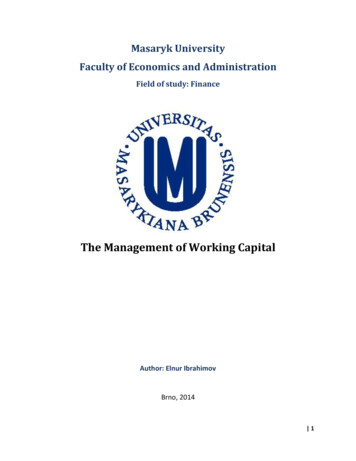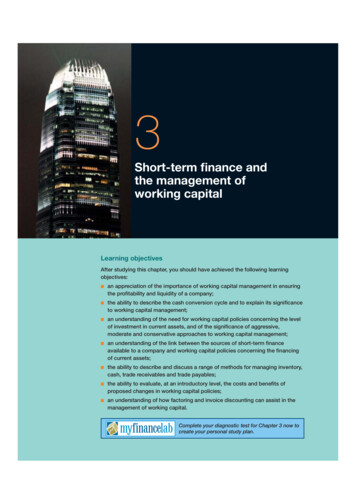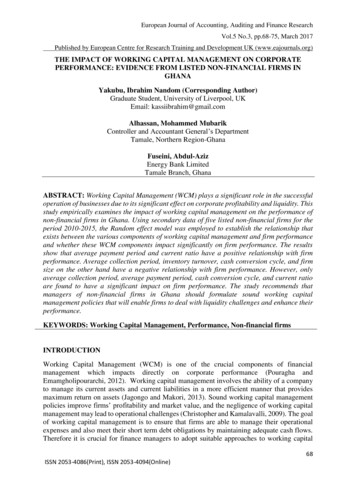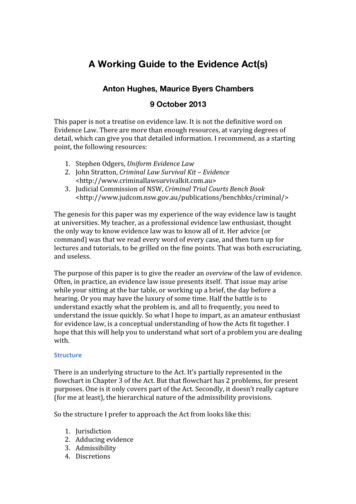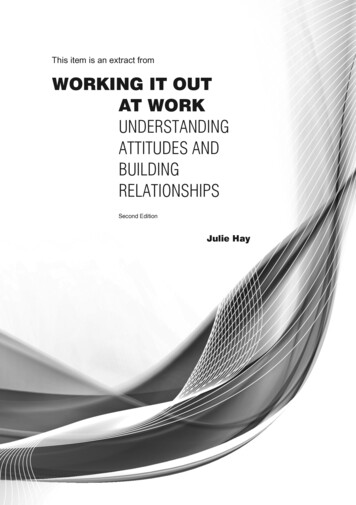
Transcription
This item is an extract fromWORKING IT OUTAT WORKUNDERSTANDINGATTITUDES ANDBUILDINGRELATIONSHIPSSecond EditionJulie Hay
This item is an extract from:Working It Out At Work – Understanding Attitudes and Building Relationships,Second EditionJulie Hay, Sherwood Publishing 2009 Julie Hay 2009
73Chapter 6:Working StyleSThere is a Working Styles Questionnaire at page 186 that you might like to complete beforeyou read this chapter.Could this be you?Chris gets through a lot of work, by doing everything very quickly. Chris moves fast, thinksfast, talks fast, and seems to do everything so much more quickly than most people.However, every so often Chris makes a mistake through rushing so much - and then it takestwice as long to put it right - especially as Chris seems intent on finding a shortcut insteadof taking time to work it through again.Chris also has a bad habit of arriving late at meetings, and of needing to leave early to getto the next meeting! And during the meeting Chris is quite likely to be openly impatientand interrupt a lot, so that people feel pressured and hurried.Pat, on the other hand, expects to arrive at and leave the meeting on time. Pat brings thecorrect files and makes sure that proper minutes are kept. Meetings with Pat progressslowly as everything must be considered in great detail.Pat is meticulous. Laid down procedures are followed to the letter - even when you arebegging Pat to make a minor exception. Everything Pat deals with is double checked andeven insignificant errors are corrected carefully and painstakingly.Other staff sometimes complain that Pat is nit-picking, especially when their own mistakesare pointed out. And Pat misses deadlines through taking too long to collect every singlepiece of information which could be relevant.Vijay is nearly always willing and helpful; nothing is too much trouble. Vijay can be verypleasant to have around, making sure that everyone on the team is comfortable. Work getsaccepted from just about anyone and sometimes Vijay does things without even being asked.However, this means that Vijay exercises little control over workload or priorities, so thatjobs get left undone when someone else needs help. Vijay sometimes gets tired andemotional from being so helpful and complains about being misunderstood.
74WORkING IT OUT AT WORkVijay also gets very anxious and upset by criticism, even when it is offered constructively.And Vijay has been known to keep quiet instead of pointing out problems - for fear ofoffending anyone!Robin is enthusiastic and interested in all aspects of work. Robin is generally the first tovolunteer when new tasks are being allocated. In fact, Robin is involved in some way injust about everything that is going on in the department and even outside it whenopportunities arise. People tend to ask for Robin's help in their section because they knowthe answer will be an enthusiastic yes.However, Robin quickly gets bored with some tasks and this often means that the worknever quite gets finished - there always seems to be another important part of the job leftto do. It is not uncommon for projects to be handed over to someone else to be completedbecause Robin's time is taken up with other new work. This sometimes leads other peopleto complain that they have to pick up work which they feel Robin should have done.Lee works steadily and produces work at a regular pace. Even when the pressure is on, Leestays calm and continues to work at the same steady rate. Lee never appears to worry aboutthe workload, and won't be hurried.Lee seems to ignore how people feel and doesn't understand the need to be flexible to dealwith those sudden emergency jobs - everything can just take its turn.Lee prefers to work alone and never asks for help. Somehow, Lee appears aloof and almostunfriendly - it's as if there are no real feelings there. Sometimes the work is not being doneafter all; Lee has tidied it away to give an appearance of coping.Working StyleSThese five people have rather extreme versions of five typical working styles. There aremany people who have similar characteristics, although most of us have more of a mix ofstyles. You may not match one of the patterns exactly but you probably recognise aspectsof a couple of them that are uncomfortably close to you. Check out your Working StyleQuestionnaire results or your responses to the following prompts:Think about what is important to you as you do your work. What aspects keep youenergised and motivated?Do you enjoy having lots to do, like Chris? Are you usually in a hurry? Can you pull outall the stops when urgent work comes up? This is the Hurry Up style.Or are you more like Pat? Do you pride yourself on your accuracy? Does it worry youwhen you see mistakes? Do you enjoy the challenge of bringing order into the world? Inthat case, you have a Be Perfect style.
WORkING STyLESIs your priority to get on well with people? Are you intuitive about how people are feeling?Are you happiest working in a team where everyone's views are taken into account? Ifyou are like Vijay, your style is Please People.Are you motivated by almost anything as long as it's new? Do you enjoy most the earlystages of each new project or task? Is it a challenge to explore different areas of work?This is the Try Hard style, like Robin.The fifth style is called Be Strong. If you are like Lee, then you pride yourself on yourability to cope. You may even welcome pressure because it gives you the chance to showhow well you can deal with it. You stay calm when there is a crisis.In the real world, people don't always fit into the neat categories of a framework like this.However, most of us still fit more into some of the categories than others. We fit even moreclosely when we are under stress as this seems to emphasise some of our weaknesses.Alan had the task of responding to a large volume of customer complaints. Alan’s manager,David, suspected that the workload was too high for one person to deal with. David waspuzzled that Alan's desk always seemed clear but the more he questioned Alan the moreinsistent Alan was that everything was under control. Offers of help were treated withsuspicion, as if Alan thought his job was at risk.Alan worked longer and longer hours and then he got the 'flu - probably because he wasrun down through overworking. At that point, David finally discovered that there was aconsiderable backlog of complaints. Alan had been filing them neatly away to maintain theappearance of coping. Like Lee, Alan was reluctant to admit problems or ask for any help,even though the workload was in fact excessive. Instead he had struggled on. David, forhis part, was a bit like Vijay - afraid to confront Alan for fear of hurting his feelings.Knowing the effect of stress on working styles means you can plan better ways of workingwith people. You can take care that you do not unintentionally make the situation evenmore stressful. Had he known about working styles, David could have insisted onmonitoring the workload himself. If he'd demanded to see the complaints and theresponses, instead of being so afraid of offending Alan, he would have known that morestaff should be allocated to this task. As it was, Alan simply got more stressed the furtherbehind he got, and the more stressed he got the more determined he became to prove hecould cope on his own.There are a number of other ways in which understanding more about our working stylescan be of use. These styles affect everything we do. They show up in the ways we organiseour work, manage our time, how we function alongside others, our contribution to theteam, our style of communication, even our sentence patterns. They have an impactwhether we are alone or with others. Greater awareness can help us build on the strengths75
76WORkING IT OUT AT WORkof our style and minimise any problems. We can also develop alternative approaches sothat our range of options is increased.DriversAs you have read, each working style has a number of benefits. Unfortunately, each stylealso has drawbacks. These drawbacks are known as drivers, so called because they have a'driven', or compulsive, quality when we are under stress. They are subconscious attemptsby us to behave in ways that will gain us the recognition we need from others. Drivers arealso programmed responses to the messages we carry in our heads from important peoplein the past. They start the unhelpful miniscript sequences described in Chapter 3.So a driver is rather like a superstition. When we were little we used to believe that if weavoided the cracks in the pavement, or crossed our fingers when we were afraid, then wewould be spared from some awful impending occurrence. In the same way, we operate asif a certain style of behaviour will ward off problems and earn us the respect of others.Unfortunately, this is a myth. The reality is that we can never do quite enough of whateverour driver calls for. In seeking to be more and more as we believe we should, we createproblems. These in turn lead to us feeling more stressed, so we put even more energy intoour driver behaviour, create more difficulties, and get yet more stressed.On the other hand, our driver characteristics are often the things we did when we werechildren because they seemed to satisfy the grown-ups. When our stress levels areacceptable, the driver will appear as a strength. It is probable, therefore, that we will beknown to others in terms of our working style and how effective it is. If they have a differentstyle, they may wish they were more like us – put them, or us, under pressure, however,and they may see only our negative aspects after all! If they share the same style, they willprobably regard us even more highly. Bosses are likely to value subordinates more whenthere is a good match of working styles.One important point to note is that drivers occur outside our awareness. We can recogniseour working styles when they are described, and even accept that the drivers also occur.However, at the time that we move into the unhelpful aspects of our working styles, we arenot conscious of doing so. We believe that we are still operating within the effective bandof the style. We need, therefore, to review our behaviour from time to time, especially whenwe are under stress, so that we can avoid the problems that driver behaviour brings.hurry UpLet's look now at each style in more detail. As you have read, if we have Hurry Upcharacteristics we work quickly and get a lot done in a short time. Our major strength isthe amount that we can achieve. We respond particularly well to short deadlines, and ourenergy peaks under pressure. We actually seem to enjoy having too many things to do. Thesaying "If you want something done, give it to a busy person." was probably coined with usin mind.
WORkING STyLESOur underlying motivation is to do things as quickly as possible. We feel good if we cancomplete tasks in the shortest possible time. Like organisation and methods specialists,we look for the most efficient way to do work in the hope of shaving even a few minutes offeach task. These few minutes can add up to significant time savings across the week. Wealso spend less time preparing than others do, giving us chance to meet more people andcontribute more to the team.However, give us time to spare and we delay starting until the job becomes urgent – thenwe start work on it. This can backfire because in our haste we make mistakes. Going backto correct the mistakes takes longer than doing the job right first time, so we may miss thedeadlines after all. At the least, the quality of our work may be poor because we have notleft enough time to check it over or improve it.Our urge to save time may be inappropriately applied to everything we do, instead of beingreserved for those tasks where it will make a real difference. Our ability to think fast maylead us to appear impatient. We speak rapidly and have a habit of interrupting others. Wemay even finish their sentences for them, sometimes incorrectly so wasting time. Our bodylanguage reflects our impatience through fidgeting, tapping with our fingers or toes,looking at our watch, and perhaps even sighing or yawning ostentatiously.Our appointments get planned too close together, so we rush from one to another, arrivinglate and leaving early. We are likely to turn up at a meeting having left the necessarypaperwork in our office; we may even fail to arrive because we didn't stop to check thelocation of the meeting. When we do arrive, others must wait while we are given a summaryof what we missed. Our constant rushing may prevent us from really getting to knowpeople, so that we feel like an outsider.A typical event for a Hurry Up is the time we approach a door that opens towards us, whilewe are carrying two cups of coffee. Most people would put one cup down, open the door,go through, put the cup down and then return to fetch the second cup. Not a Hurry Up,though. We juggle! Usually it’s quicker. Every so often, it’s a lot slower because we have tostop to clean up the coffee we spill. (If you never get the coffees, imagine an armful of filesto be picked up from the floor, or the pulled muscle from carrying too many bags ofgroceries in one trip from the car, or the piece of wood that is too short because you didn'tcheck the measurement carefully before you sawed!)Be perfectBe Perfect people are as unlike Hurry Up's as can be. Our motto is: "If a job is worth doing,it's worth doing well". Be Perfect characteristics involve a quest for perfection – no errors,everything must be exactly right, first time. Our major strength is our reputation forproducing accurate, reliable work. We check the facts carefully, we prepare thoroughly andwe pay attention to the details. Our written work will look good because we aim forperfection in layout as well as content.77
78WORkING IT OUT AT WORkThis working style means we are well organised because we look ahead and plan how
Chapter 6: Working StyleS There is a Working Styles Questionnaire at page 186 that you might like to complete before you read this chapter. Could this be you? Chris gets through a lot of work, by doing everything very quickly. Chris moves fast, thinks fast, talks fast, and seems to do everything so much more quickly than most people. However, every so often Chris makes a mistake through .
